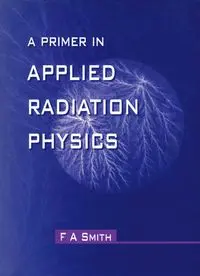
A Primer in Applied Radiation Physics - F. Smith (World, 2000) WW PDF
Preview A Primer in Applied Radiation Physics - F. Smith (World, 2000) WW
Published by World Scientific Publishing Co. Re. Ltd. P 0 Box 128, Farrer Road, Singapore 912805 USA office: Suite IB, 1060 Main Street, River Edge, NJ 07661 UK ofice: 57 Shelton Street, Covent Garden, London WC2H 9HE British Library Cataloguing-in-Publication Data A catalogue record for this book is available from the British Library. A PRIMER IN APPLIED RADIATION PHYSICS Copyright 8 2000 by World Scientific Publishing Co. Re. Ltd. All rights resewed. This book, or parts thereof; may not be reproduced in any form or by any means, electronic or mechanical, including photocopying, recording or any information storage and retrieval system now known or to be invented, without written permission from the Publisher. For photocopying of material in this volume, please pay a copying fee through the Copyright Clearance Center, Inc., 222 Rosewood Drive, Danvers, MA 01923, USA. In this case permission to photocopy is not required from the publisher. ISBN 981-02-3712-X ISBN 981-02-3713-8 (pbk) Printed in Singapore by Uto-Print To Mary (for her patience) The aim of this volume is threefold. It is intended, firstly, as a revision aid for students on Masters level degree courses in Radiation Science. These will already have received lectures at various levels of detail on most of the topics covered here. Experience has shown, however, that in preparing for examinations, especially oral examinations, students benefit from an opportunity to put details in the context of the whole. This I have tried to do by drawing attention to important connections that exist between topics treated in different chapters. These generally involve an understanding of basic interaction processes. Secondly, now that many universities and colleges offer courses in Radiation or Medical Physics to undergraduates, I have included a few examples of the basic concepts at a rather more elementary level in order to provide an introduction to the field. I will have achieved my aim of widening the appreciation of radiation science if this then leads to further study. Thirdly, it is hoped that the book will provide a general introduction to Radiation Physics in general. My aim has been to make a comprehensive survey of what I believe to be the most significant current practices and techniques. In the interests of completeness I have included a treatment of neutron interactions and some of their applications, even though neutrons have not lived up to their expectations, either as a mode of radiotherapy or as the foundation of power generation. The book is therefore not a textbook. Still less, is it a practical manual for hospital physicists, although it may act occasionally in both capacities. Its aim is to draw together the diversity of a subject that touches on aspects of biology and chemistry as well as on many branches of physics. Although it is ionizing radiation that is of prime concern, the importance of magnetic resonance as an imaging modality is acknowledged briefly. Even though a similar case could be made for ultrasound imaging, there is a less obvious connection with radiation, and this topic is not covered. In any case, imaging as a whole has a vast array of literature, with many excellent reviews already extant. The imaging chapter is therefore no more than a personal survey of selected topics. The material is based on my role as both lecturer and examiner on the University of London MSc. course in Radiation Physics, and also on my experience in teaching a third year B.Sc. course at Queen Mary and Westfield College. vii viii PREFACE I am most grateful to those of my colleagues who took the trouble to offer constructive comments and criticisms on some of my early drafts. Amongst these I particularly thank John Barton, Ian Blair, Alan Edwards, Gerry Lowe, Seeni Naidu, Beate Planskoy, Robert Speller and Jane Taylor. Additional advice and data for some of the figures and tables came from Julie Horrocks, John Lowe, Cyril Nimmon and Mark Roper. At the inception of the project the encouragement, enthusiasm and general bonhomie of the late Stan Klevenhagen gave me considerable insight into all aspects of hospital physics. My more amateurish sketches were redrawn willingly by Steve Adams, to whom I am also extremely indebted for greatly assisting in the overall presentation.
